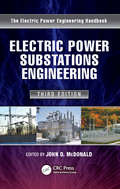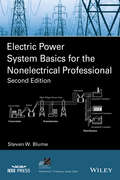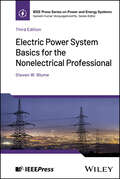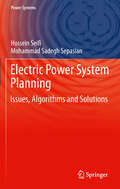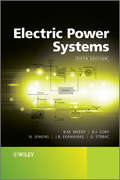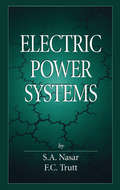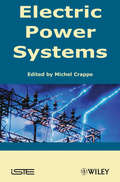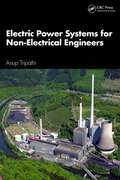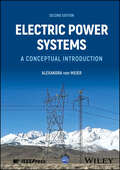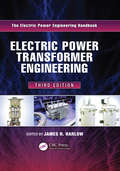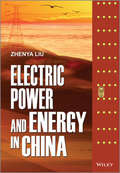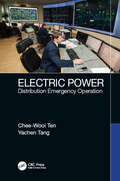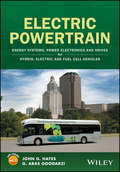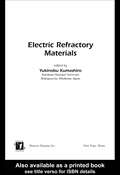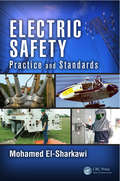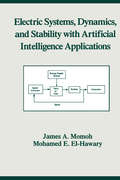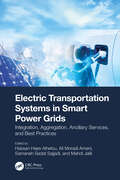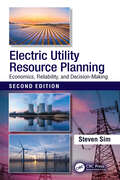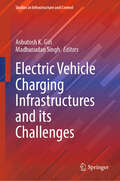- Table View
- List View
Electric Power Substations Engineering (Electrical Engineering Handbook)
by John D. McdonaldThe use of electric power substations in generation, transmission, and distribution remains one of the most challenging and exciting areas of electric power engineering. Recent technological developments have had a tremendous impact on all aspects of substation design and operation. With 80% of its chapters completely revised and two brand-new chapters on energy storage and Smart Grids, Electric Power Substations Engineering, Third Edition provides an extensive updated overview of substations, serving as a reference and guide for both industry and academia. Contributors have written each chapter with detailed design information for electric power engineering professionals and other engineering professionals (e.g., mechanical, civil) who want an overview or specific information on this challenging and important area. This book: Emphasizes the practical application of the technology Includes extensive use of graphics and photographs to visually convey the book’s concepts Provides applicable IEEE industry standards in each chapter Is written by industry experts who have an average of 25 to 30 years of industry experience Presents a new chapter addressing the key role of the substation in Smart Grids Editor John McDonald and this very impressive group of contributors cover all aspects of substations, from the initial concept through design, automation, and operation. The book’s chapters—which delve into physical and cyber-security, commissioning, and energy storage—are written as tutorials and provide references for further reading and study. As with the other volumes in the Electric Power Engineering Handbook series, this book supplies a high level of detail and, more importantly, a tutorial style of writing and use of photographs and graphics to help the reader understand the material. Several chapter authors are members of the IEEE Power & Energy Society (PES) Substations Committee and are the actual experts who are developing the standards that govern all aspects of substations. As a result, this book contains the most recent technological developments in industry practice and standards. Watch John D. McDonald talk about his book A volume in the Electric Power Engineering Handbook, Third Edition. Other volumes in the set: K12642 Electric Power Generation, Transmission, and Distribution, Third Edition (ISBN: 9781439856284) K12648 Power Systems, Third Edition (ISBN: 9781439856338) K13917 Power System Stability and Control, Third Edition (ISBN: 9781439883204) K12643 Electric Power Transformer Engineering, Third Edition (ISBN: 9781439856291)
Electric Power System Applications of Optimization (Second Edition)
by James A. Momoh<p>As the demand for energy continues to grow, optimization has risen to the forefront of power engineering research and development. Continuing in the bestselling tradition of the first edition, Electric Power System Applications of Optimization, Second Edition presents the theoretical background of optimization from a practical power system point of view, exploring advanced techniques, new directions, and continuous application problems. <p>The book provides both the analytical formulation of optimization and various algorithmic issues that arise in the application of various methods in power system planning and operation. The second edition adds new functions involving market programs, pricing, reliability, and advances in intelligent systems with implemented algorithms and illustrative examples. It describes recent developments in the field of Adaptive Critics Design and practical applications of approximate dynamic programming. To round out the coverage, the final chapter combines fundamental theories and theorems from functional optimization, optimal control, and dynamic programming to explain new Adaptive Dynamic Programming concepts and variants. <p>With its one-of-a-kind integration of cornerstone optimization principles with application examples, this second edition propels power engineers to new discoveries in providing optimal supplies of energy.</p>
Electric Power System Basics for the Nonelectrical Professional (2nd Edition)
by Steven W. BlumeThe second edition of Steven W. Blume's bestseller provides a comprehensive treatment of power technology for the non-electrical engineer working in the electric power industry This book aims to give non-electrical professionals a fundamental understanding of large interconnected electrical power systems, better known as the "Power Grid", with regard to terminology, electrical concepts, design considerations, construction practices, industry standards, control room operations for both normal and emergency conditions, maintenance, consumption, telecommunications and safety. The text begins with an overview of the terminology and basic electrical concepts commonly used in the industry then it examines the generation, transmission and distribution of power. Other topics discussed include energy management, conservation of electrical energy, consumption characteristics and regulatory aspects to help readers understand modern electric power systems. This second edition features: New sections on renewable energy, regulatory changes, new measures to improve system reliability, and smart technologies used in the power grid system Updated practical examples, photographs, drawing, and illustrations to help the reader gain a better understanding of the material "Optional supplementary reading" sections within most chapters to elaborate on certain concepts by providing additional detail or background Electric Power System Basics for the Nonelectrical Professional, Second Edition, gives business professionals in the industry and entry-level engineers a strong introduction to power technology in non-technical terms. Steve W. Blume is Founder of Applied Professional Training, Inc., APT Global, LLC, APT College, LLC and APT Corporate Training Services, LLC, USA. Steve is a registered professional engineer and certified NERC Reliability Coordinator with a Master's degree in Electrical Engineering specializing in power and a Bachelor's degree specializing in Telecommunications. He has more than 25 years' experience teaching electric power system basics to non-electrical professionals. Steve's engineering and operations experience includes generation, transmission, distribution, and electrical safety. He is an active senior member in IEEE and has published two books in power systems through IEEE and Wiley.
Electric Power System Basics for the Nonelectrical Professional (IEEE Press Series on Power and Energy Systems)
by Steven W. BlumeUnderstand the fundamentals of electrical power systems with this accessible guide Few subjects are more fundamental to modern life than electrical power. The systems that generate, transport, and distribute electricity are among the most essential contributors to modern industry, development, and everyday living. As energy demand grows and, with it, the electric power industry, more and more non-electrical professionals must make important policy and administrative decisions regarding the systems that power our world. Electric Power System Basics for the Nonelectrical Professional provides an education on the basics of this subject, including the various types of energy sources, types of transmission and distribution lines, grid modernization, and much more. From residential to industrial energy, and from metering principles to energy conservation techniques, this book provides a one-stop reference on all relevant areas of knowledge. Now fully updated to reflect the latest advances and the current state of a growing industry, it is a must-own for anyone looking to bring foundational power systems knowledge to bear on policy or industrial issues. Readers of the third edition will also find: Coverage of wildfire mitigation strategies to reduce safety riskDetailed discussion of regulatory changes and their effects on system operationsUpdated coverage of system reliability and smart technologiesUpdated discussion of the transitioning digital power grid Electric Power System Basics for the Nonelectrical Professional is ideal for power industry executives and state regulators.
Electric Power System Planning
by Hossein Seifi Mohammad Sadegh SepasianThe present book addresses various power system planning issues for professionals as well as senior level and postgraduate students. Its emphasis is on long-term issues, although much of the ideas may be used for short and mid-term cases, with some modifications. Back-up materials are provided in twelve appendices of the book. The readers can use the numerous examples presented within the chapters and problems at the end of the chapters, to make sure that the materials are adequately followed up. Based on what Matlab provides as a powerful package for students and professional, some of the examples and the problems are solved in using M-files especially developed and attached for this purpose. This adds a unique feature to the book for in-depth understanding of the materials, sometimes, difficult to apprehend mathematically. Chapter 1 provides an introduction to Power System Planning (PSP) issues and basic principles. As most of PSP problems are modeled as optimization problems, optimization techniques are covered in some details in Chapter 2. Moreover, PSP decision makings are based on both technical and economic considerations, so economic principles are briefly reviewed in Chapter 3. As a basic requirement of PSP studies, the load has to be known. Therefore, load forecasting is presented in Chapter 4. Single bus Generation Expansion Planning (GEP) problem is described in Chapter 5. This study is performed using WASP-IV, developed by International Atomic Energy Agency. The study ignores the grid structure. A Multi-bus GEP problem is discussed in Chapter 6 in which the transmission effects are, somehow, accounted for. The results of single bus GEP is used as an input to this problem. SEP problem is fully presented in Chapter 7. Chapter 8 devotes to Network Expansion Planning (NEP) problem, in which the network is planned. The results of NEP, somehow, fixes the network structure. Some practical considerations and improvements such as multi-voltage cases are discussed in Chapter 9. As NEP study is typically based on some simplifying assumptions and Direct Current Load Flow (DCLF) analysis, detailed Reactive Power Planning (RPP) study is finally presented in Chapter 10, to guarantee acceptable ACLF performance during normal as well as contingency conditions. This, somehow, concludes the basic PSP problem. The changing environments due to power system restructuring dictate some uncertainties on PSP issues. It is shown in Chapter 11 that how these uncertainties can be accounted for. Although is intended to be a text book, PSP is a research oriented topic, too. That is why Chapter 12 is devoted to research trends in PSP. The chapters conclude with a comprehensive example in Chapter 13, showing the step-by-step solution of a practical case.
Electric Power Systems
by N. Jenkins B. J. Cory B. M. Weedy G. Strbac J. B. EkanayakeThe definitive textbook for Power Systems students, providing a grounding in essential power system theory while also focusing on practical power engineering applications.Electric Power Systems has been an essential book in power systems engineering for over thirty years. Bringing the content firmly up-to-date whilst still retaining the flavour of Weedy's extremely popular original, this Fifth Edition has been revised by experts Nick Jenkins, Janaka Ekanayake and Goran Strbac. This wide-ranging text still covers all of the fundamental power systems subjects but is now expanded to cover increasingly important topics like climate change and renewable power generation. Updated material includes an analysis of today's markets and an examination of the current economic state of power generation. The physical limits of power systems equipment - currently being tested by the huge demand for power - is explored, and greater attention is paid to power electronics, voltage source and power system components, amongst a host of other updates and revisions.Supplies an updated chapter on power system economics and management issues and extended coverage of power system components. Also expanded information on power electronics and voltage source, including VSC HVDC and FACTS. Updated to take into account the challenges posed by different world markets, and pays greater attention to up-to-date renewable power generation methods such as wind power. Includes modernized presentation and greater use of examples to appeal to today's students, also retains the end of chapter questions to assist with the learning process. Also shows students how to apply calculation techniques.
Electric Power Systems
by Syed A. Nasar F. C TruttThe field of electrical engineering has become increasingly diversified, resulting in a spectrum of emerging topics - from microelectromechanics to light-wave technology. Keeping pace with progressing technology, and covering the scope of related subjects, Electric Power Systems provides introductory, fundamental knowledge in several areas. The tex
Electric Power Systems (Wiley-iste Ser.)
by Michel CrappeThe creation of a European liberalized electricity internal market and EU commitments for the reduction of greenhouse gas emissions (Kyoto Protocol) and for the use of renewable energy generation technologies induce new important constraints and problems on the electric power systems in Europe. This then creates the need for more research and development to engage with these new challenges in order to preserve the reliability of these systems. This book aims to provide advanced tools, covering major aspects, for people involved with such research and development. Split into two parts (the first covering the operation and control of electric power systems and the second the stability and defence of electric power systems), this book gathers together contributions from numerous well-known European specialists in academia and the electrical industry and will be an illuminating read for those involved in this field or who have some knowledge of the fundamental notions.
Electric Power Systems for Non-Electrical Engineers
by Anup Kumar TripathiThis book explains the electrical power systems for non-electrical engineers and includes topics like electrical energy systems, electrical power systems structure, single-phase AC circuit fundamentals and three-phase systems, power system modeling, power system representation, power system operation, power flow analysis, economic operation of power systems, power system fault analysis, power system protection fundamentals, and so forth. Examples have been provided to clarify the description, and review questions are provided at the end of each chapter.Features: Provides a simplified description of fundamentals of electrical energy systems and structure of electrical power systems for non-electrical engineers. Gives a detailed description of AC circuit fundamentals and three-phase systems. Describes power system modeling and power system representation. Covers power system operation, power flow analysis, and fundamentals of economic operation of power systems. Discusses power system fault analysis and fundamentals of power system protection with examples, and also includes renewable energy systems. This book has been aimed at senior undergraduate and graduate students of non-electrical engineering background.
Electric Power Systems: A Conceptual Introduction (Wiley Survival Guides In Engineering And Science Ser. #8)
by Alexandra von MeierDiscover the technology for producing and delivering electricity in this easily accessible introduction to power systems Electric Power Systems underlie virtually every aspect of modern life. In the face of an unprecedented transition from fossil fuels to clean energy, it has never been more essential for engineers and other professionals from diverse disciplines to understand the electric grid and help chart its future. Since its original publication, Electric Power Systems has served as a uniquely accessible and qualitative introduction to the subject, offering a foundational overview with an emphasis on key concepts and building physical intuition. Now revised and updated to bring even greater rigor and incorporate the latest technologies, it remains an indispensable introduction to this vital subject. Readers of the revised and expanded second edition of Electric Power Systems will also find: End-of-chapter problems to facilitate and reinforce learning New discussions of subjects including load frequency control, protection, voltage stability, and many others More quantitative treatment of topics such as voltage regulation, power flow analysis, generator and transformer modeling with numerical examples Entirely new chapters on generation and storage resources, power electronics, and the analysis of transmission lines Electric Power Systems is an ideal textbook for graduate and advanced undergraduate students in engineering, as well as for a broad range of professionals, such as computer and data scientists, solar and wind energy manufacturers and installers, energy storage providers, economists, policy makers, legal and regulatory staff, and advocacy organizations.
Electric Power Systems: Advanced Forecasting Techniques and Optimal Generation Scheduling
by João P. S. CatalãoElectric Power Systems: Advanced Forecasting Techniques and Optimal Generation Scheduling helps readers develop their skills in modeling, simulating, and optimizing electric power systems. Carefully balancing theory and practice, it presents novel, cutting-edge developments in forecasting and scheduling. The focus is on understanding and solving pivotal problems in the management of electric power generation systems. Methods for Coping with Uncertainty and Risk in Electric Power Generation Outlining real-world problems, the book begins with an overview of electric power generation systems. Since the ability to cope with uncertainty and risk is crucial for power generating companies, the second part of the book examines the latest methods and models for self-scheduling, load forecasting, short-term electricity price forecasting, and wind power forecasting. Toward Optimal Coordination between Hydro, Thermal, and Wind Power Using case studies, the third part of the book investigates how to achieve the most favorable use of available energy sources. Chapters in this section discuss price-based scheduling for generating companies, optimal scheduling of a hydro producer, hydro-thermal coordination, unit commitment with wind generators, and optimal optimization of multigeneration systems. Written in a pedagogical style that will appeal to graduate students, the book also expands on research results that are useful for engineers and researchers. It presents the latest techniques in increasingly important areas of power system operations and planning.
Electric Power Transformer Engineering
by Alice Wilmere Norton ShawElectric Power Transformer Engineering, Third Edition expounds the latest information and developments to engineers who are familiar with basic principles and applications, perhaps including a hands-on working knowledge of power transformers. Targeting all from the merely curious to seasoned professionals and acknowledged experts, its content is structured to enable readers to easily access essential material in order to appreciate the many facets of an electric power transformer. Topically structured in three parts, the book: Illustrates for electrical engineers the relevant theories and principles (concepts and mathematics) of power transformers Devotes complete chapters to each of 10 particular embodiments of power transformers, including power, distribution, phase-shifting, rectifier, dry-type, and instrument transformers, as well as step-voltage regulators, constant-voltage transformers, transformers for wind turbine generators and photovoltaic applications, and reactors Addresses 14 ancillary topics including insulation, bushings, load tap changers, thermal performance, testing, protection, audible sound, failure analysis, installation and maintenance and more As with the other books in the series, this one supplies a high level of detail and, more importantly, a tutorial style of writing and use of photographs and graphics to help the reader understand the material. Important chapters have been retained from the second edition; most have been significantly expanded and updated for this third installment. Each chapter is replete with photographs, equations, and tabular data, and this edition includes a new chapter on transformers for use with wind turbine generators and distributed photovoltaic arrays. Jim Harlow and his esteemed group of contributors offer a glimpse into the enthusiastic community of power transformer engineers responsible for this outstanding and best-selling work. A volume in the Electric Power Engineering Handbook, Third Edition. Other volumes in the set: K12642 Electric Power Generation, Transmission, and Distribution, Third Edition (ISBN: 9781439856284) K12648 Power Systems, Third Edition (ISBN: 9781439856338) K13917 Power System Stability and Control, Third Edition (9781439883204) K12650 Electric Power Substations Engineering, Third Edition (9781439856383) Watch James H. Harlow's talk about his book: Part One: http://youtu.be/fZNe9L4cux0 Part Two: http://youtu.be/y9ULZ9IM0jE Part Three: http://youtu.be/nqWMjK7Z_dg
Electric Power and Energy in China
by Zhenya LiuThe acute energy problems facing China today are characterized by their own histories and realities. Some have come about because of China's energy endowment and stage of development, while others have been created by a combination of domestic and global factors. Some are the results of an accumulation of longstanding contradictions, while others are new challenges posed by the new order. There are no "miracle cures" to solve these problems instantly. What is needed is a tireless enquiry, with goals, planning and procedures, guided by a clear energy strategy. With China's increasing dependence on foreign energy sources, and the global energy situation and greenhouse gas issue exerting an increasingly prohibiting effect on China's energy development, energy diplomacy has become an important component of Chinese diplomatic affairs. Based on a "broad energy outlook", this book studies and analyzes China's energy issues and energy strategies from the perspective of electric power. Discusses a variety of issues, including energy transportation and allocation, end-user consumption, markets, early warning and emergency, technical innovation As a leading player in the power and energy area, China’s strategies attracts global attention Proposes the innovative idea of "Macro Energy Perspective" As a key player in China's energy industrial circle, the author's perspective can help global audiences to understand China's energy strategies better Electric Power and Energy in China is ideal for government energy policy makers, engineers, scientists and enterprise managers to understand China’s strategy in electric power and energy. It is also a good reference for energy economics researchers, consultants and university students.
Electric Power: Distribution Emergency Operation
by Chee-Wooi Ten Yachen TangProvides the fundamentals of distribution emergency operation using graph-theoretic approach and exploration of subsystem(s) that address the operational aspects of fault occurrence to determine the possible feeder reconfiguration. Topics include: (1) Data extraction from geographic information systems (GIS), (2) Graph modeling of distribution feeders, (3) Programming for backward/forward sweeping unbalanced power flow, (4) Short circuit analysis and fault localization, (5) Fault isolation and service restoration, (6) Outage management and crew coordination, (7) Trouble call tickets and escalation to search for fault, and (8) Emerging topics of distribution management systems (DMS).
Electric Powertrain: Energy Systems, Power Electronics and Drives for Hybrid, Electric and Fuel Cell Vehicles
by John G. Hayes G. Abas GoodarziEmpowers engineering professionals and students with the knowledge and skills required to engineer electric vehicle powertrain architectures, energy storage systems, power electronics converters and electric drives. The modern electric powertrain is relatively new for the automotive industry, and engineers are challenged with designing affordable, efficient and high-performance electric powertrains as the industry undergoes a technological evolution. Co-authored by two electric vehicle (EV) engineers with decades of experience designing and putting into production all of the powertrain technologies presented, this book provides readers with the hands-on knowledge, skills and expertise they need to rise to that challenge.This four-part practical guide provides a comprehensive review of battery, hybrid and fuel cell EV systems and the associated energy sources, power electronics, machines, and drives. The first part of the book begins with a historical overview of electromobility and the related environmental impacts motivating the development of the electric powertrain. Vehicular requirements for electromechanical propulsion are then presented. Battery electric vehicles (BEV), fuel cell electric vehicles (FCEV), and conventional and hybrid electrical vehicles (HEV) are then described, contrasted and compared for vehicle propulsion. The second part of the book features in-depth analysis of the electric powertrain traction machines, with a particular focus on the induction machine and the surface- and interior-permanent magnet ac machines. The brushed dc machine is also considered due to its ease of operation and understanding, and its historical place, especially as the traction machine on NASA’s Mars rovers. The third part of the book features the theory and applications for the propulsion, charging, accessory, and auxiliary power electronics converters. Chapters are presented on isolated and non-isolated dc-dc converters, traction inverters, and battery charging. The fourth part presents the introductory and applied electromagnetism required as a foundation throughout the book. • Introduces and holistically integrates the key EV powertrain technologies.• Provides a comprehensive overview of existing and emerging automotive solutions.• Provides experience-based expertise for vehicular and powertrain system and sub-system level study, design, and optimization.• Presents many examples of powertrain technologies from leading manufacturers.• Discusses the dc traction machines of the Mars rovers, the ultimate EVs from NASA.• Investigates the environmental motivating factors and impacts of electromobility.• Presents a structured university teaching stream from introductory undergraduate to postgraduate.• Includes real-world problems and assignments of use to design engineers, researchers, and students alike.• Features a companion website with numerous references, problems, solutions, and practical assignments.• Includes introductory material throughout the book for the general scientific reader.• Contains essential reading for government regulators and policy makers.Electric Powertrain: Energy Systems, Power Electronics and Drives for Hybrid, Electric and Fuel Cell Vehicles is an important professional resource for practitioners and researchers in the battery, hybrid, and fuel cell EV transportation industry. The book is a structured holistic textbook for the teaching of the fundamental theories and applications of energy sources, power electronics, and electric machines and drives to engineering undergraduate and postgraduate students.Textbook Structure and Suggested Teaching CurriculumThis is primarily an engineering textbook covering the automotive powertrain, energy storage and energy conversion, power electronics, and electrical m
Electric Refractory Materials
by Yukinobu KumashiroAn exploration of electric refractory materials, this book covers developments of blue light-emitting diodes using GaN-based nitrides for laser and high-temperature and -frequency devices. Electric Refractory Materials introduces growth and evaluation standards of films and bulk crystals, with consideration of band structure, surface electronic structure, and lattice vibrations. It also covers heat capacity and thermal conductivity, irradiation properties, and selective surfaces. Focusing on diamond material, the book examines its synthesis and characterization as well as its electrical, optical, and conductive properties. The book also discusses the use of silicon carbide, boron compounds, and other material used in electronic and light-emitting devices.
Electric Relays: Principles and Applications (Electrical and Computer Engineering #Vol. 130)
by Vladimir GurevichElectric relays pervade the electronics that dominate our world. They exist in many forms, fulfill many roles, and each have their own behavioral nuances and peculiarities. To date, there exists no comprehensive reference surveying the broad spectrum of electric relays, save one-Electric Relays: Principles and Applications. This ambitious work is not only unique in its scope, but also in its practical approach that focuses on the operational and functional aspects rather than on theory and mathematics.Accomplished engineer Dr. Vladimir Gurevich builds the presentation from first principles, unfolding the concepts and constructions via discussion of their historical development from the earliest ideas to modern technologies. He uses a show-not-tell approach that employs nearly 1300 illustrations and reveals valuable insight based on his extensive experience in the field. The book begins with the basic principles of relay construction and the major functional parts, such as contact and magnetic systems. Then, it devotes individual chapters to the various types of relays. The author describes the principles of function and construction for each type as well as features of several relays belonging to a type that operate on different principles.Remarkably thorough and uniquely practical, Electric Relays: Principles and Applications serves as the perfect introduction to the plethora of electric relays and offers a quick-reference guide for the experienced engineer.
Electric Safety: Practice and Standards
by Mohamed A. El-SharkawiElectric power engineering education traditionally covers safety of the power equipment and systems. Little attention, if any, is given to the safety of people. When they reach professional status, most power engineers are not familiar with electric safety issues such as practices governing site works or grounding techniques of dwellings, hospitals
Electric Sounds: Technological Change and the Rise of Corporate Mass Media (Film and Culture Series)
by Steve WurtzlerElectric Sounds brings to vivid life an era when innovations in the production, recording, and transmission of sound revolutionized a number of different media, especially the radio, the phonograph, and the cinema. The 1920s and 1930s marked some of the most important developments in the history of the American mass media: the film industry's conversion to synchronous sound, the rise of radio networks and advertising-supported broadcasting, the establishment of a federal regulatory framework on which U.S. communications policy continues to be based, the development of several powerful media conglomerates, and the birth of a new acoustic commodity in which a single story, song, or other product was made available to consumers in multiple media forms and formats.But what role would this new media play in society? Celebrants saw an opportunity for educational and cultural uplift; critics feared the degradation of the standards of public taste. Some believed acoustic media would fulfill the promise of participatory democracy by better informing the public, while others saw an opportunity for manipulation. The innovations of this period prompted not only a restructuring and consolidation of corporate mass media interests and a shift in the conventions and patterns of media consumption but also a renegotiation of the social functions assigned to mass media forms. Steve J. Wurtzler's impeccably researched history adds a new dimension to the study of sound media, proving that the ultimate form technology takes is never predetermined. Rather, it is shaped by conflicting visions of technological possibility in economic, cultural, and political realms. Electric Sounds also illustrates the process through which technologies become media and the ways in which media are integrated into American life.
Electric Systems, Dynamics, and Stability with Artificial Intelligence Applications (Power Engineering #8)
by Mohamed E. El-Hawary James A. MomohThis work seeks to provide a solid foundation to the principles and practices of dynamics and stability assessment of large-scale power systems, focusing on the use of interconnected systems - and aiming to meet the requirements of today's competitive and deregulated environments. It contains easy-to-follow examples of fundamental concepts and algorithmic procedures.
Electric Transportation Systems in Smart Power Grids: Integration, Aggregation, Ancillary Services, and Best Practices
by Hassan Haes Alhelou Ali Moradi Amani Samaneh Sadat Sajjadi Mahdi JaliliThe leading countries around the globe, including Australia, have taken serious steps to decarbonize their energy and transportation sectors as part of their obligations for a suitable future with fewer emissions and a better environment. The decarbonization plans in different countries have resulted in changes such as increases in the penetration level of renewable energy sources and the introduction of electric vehicles as a target for future transportation systems. This is the point where mobility meets electricity and brings new challenges and opportunities, especially in the integration with modern power systems. The main impact would be on the demand-side and the distribution network. These impacts would be also reflected in the operation, control, security, and stability of transmission systems. This creates a new grid architecture characterized by a growing variability and uncertainties. Moreover, the growth in the share of renewable energy in the total energy market is one of the major causes of the increasing fluctuations in the balance between generation and consumption in the whole system. Therefore, the key challenge lies in developing new concepts to ensure the effective integration of distributed energy resources and electric transportation systems, including EVs, into existing and future market structures. Electric Transportation Systems in Smart Power Grids address how these issues—EVs, E-buses, and other smart appliances on the demand side—can be aggregated to form virtual power plants, which are considered an efficient solution to provide operational flexibility to the grid. The book also discusses how EV-based virtual power plants can also provide myriad services for distribution system operators, transmission system operators, and even local prosumers within the energy community. Features: Describes the services required to power systems from EVs and electric transportation sector Covers frequency control in modern power systems using aggregated EVs Discusses the integration and interaction between EVs and Smart grids Introduces electric vehicle aggregation methods for supporting power systems Highlights flexibility provided from electric transportation system to smart energy sector Discusses the high penetration level of renewable energy sources and EVs
Electric Utility Resource Planning: Economics, Reliability, and Decision-Making
by Steven SimMost people—including many legislators, regulators, and other decision makers in the electric utility industry—have misconceptions about how electric utilities really "work" and plan for the future. This lack of understanding can lead to poorly informed decisions and policies that directly affect the choices utilities must make. Using easy-to-understand text and examples, Electric Utility Resource Planning: Economics, Reliability, and Decision-Making clarifies how utilities operate their systems and prepare for the future. This explanation will show readers that both expected and counterintuitive results can occur (i.e., conservation might result in higher air emissions, or lowering costs could lead to higher electric rates). Taking readers step by step through this process, the book (in the following order): "Creates" a hypothetical utility Explains how and why a utility operates its system of generating units Discusses the planning methods that a utility would (or should) use Guides readers through each stage of a planning analysis for the hypothetical utility, examining various resource options (conservation, new power plants, and solar) In addition, the author introduces four Fundamental Principles of Resource Planning that should guide utilities. He also offers opinions on how certain trends in utility regulation and legislation can hinder utility planners’ efforts to identify and select the best resources for the utility’s customers. With this book, author Dr. Steven Sim applies his experience and insights from more than two decades of resource planning for Florida Power and Light (FPL). As one of the largest utilities in the United States, FPL has faced a multitude of resource planning challenges, and Dr. Sim has performed and supervised thousands of analyses designed to meet these obstacles. He has also served as an FPL witness in regulatory hearings on a wide variety of topics, ranging from the economic implications of nuclear, conservation, coal, gas, and other resource options, to the non-economic impacts (air emissions, fuel usage, system reliability, etc.) they present.
Electric Utility Resource Planning: Economics, Reliability, and Decision-Making
by Steven SimIn 2012, using easy-to-understand text and examples, the first edition of this book explained how electric utilities “work,” and how they plan (or should plan) for the future, by: "Creating" a hypothetical electric utility Explaining how (and why) this utility will operate its system of generating units Guiding readers through a planning analysis for the utility, examining various resource options (solar, new gas-fueled generation, and conservation) Introducing four Fundamental Principles of Resource Planning that should guide utilities as they plan for the future The first edition material, with significant updates, now appears as Part I of the second edition of this book. Part II of this book then presents six all-new chapters that address the challenges (and opportunities) of moving toward a zero-carbon future. Using the same hypothetical utility, with its new goal to utilize solar and batteries to serve 100% of its customers’ energy with zero carbon emissions by a future “target”year, Part II of this book addresses many subjects, including: The enormous amount of MW of new solar and batteries the utility will need to add Why certain characteristics of new solar and battery additions change as increasing amounts of these resources are added In the years prior to achieving its zero-carbon goal, how the hourly operation of the utility’s existing fossil-fueled generators, plus the new solar, will change (and why the stability of the transmission grid will be challenged) With this second edition, author Dr. Steven Sim again applies the experience and insights he gained from more than 30 years of resource planning for Florida Power & Light (FPL). As one of the largest electric utilities in the United States, FPL has faced a multitude of resource planning challenges, including how to get to zero carbon. During this time period, Dr. Sim performed and directed thousands of analyses designed to address these challenges. He also served as an expert witness in dozens of regulatory hearings, addressing both the economics of resource options and the non-economic impacts (air emissions, system reliability, fuel usage, etc.) associated with these options.
Electric Vehicle Batteries: From Sourcing to Second Life and Recycling
by Bob Galyen Frank MenchacaUnderstand the batteries that will power the sustainable transition from innovators who are making it happen The transition from fossil-fuel based energy sources to electricity is one of the most crucial technological milestones in the world today. The surge of electric vehicle production will require hundreds of millions of electric vehicle batteries, the creation of which have environmental impacts of their own. There is an urgent need for resources which analyze these impacts, their role in the life cycle of a battery, and the broader challenges and opportunities of this electric transition. Electric Vehicle Batteries: From Sourcing to Second Life and Recycling meets this need with a thorough, accessible overview of batteries: how they are made, used, and re-used. Balancing theory and practice, and with coverage of all relevant vehicle types, it’s a crucial resource for engineers, scientists, students, and instructors. Created by some of the leading experts in the mobility industry, Electric Vehicle Batteries is a decisive contribution to the fight for a sustainable future. In Electric Vehicle Batteries: From Sourcing to Second Life and Recycling, readers will find: A programmatic structure for creating new engineering practices and teams that support them A safety-first approach to handling volatile materials An authorial and editorial team with extensive experience in both engineering and management Electric Vehicle Batteries: From Sourcing to Second Life and Recycling is ideal for reskilling engineers, undergraduate students, and other new entrants into the rapidly expanding field of electric vehicle production.
Electric Vehicle Charging Infrastructures and its Challenges (Studies in Infrastructure and Control)
by Madhusudan Singh Ashutosh K. GiriThe book presents basic terminologies of charging infrastructures such as types, levels, and suitable power converters applications. Various energy storage technologies, such as lithium-ion batteries charging strategies and battery management system (BMS) and battery swapping, are discussed in the book. In this book, some guidelines by the Ministry of Power and Ministry of Housing (Government of India) are discussed which can help an individual to set up a charging infrastructure at their end. Also, the novel idea and concepts developed by the researchers/academia and practicing engineers working in the domain of the EV charging infrastructures are incorporated. The active and reactive power control strategy along with other parameters estimation and control are also included to make this book popular among the readers.
